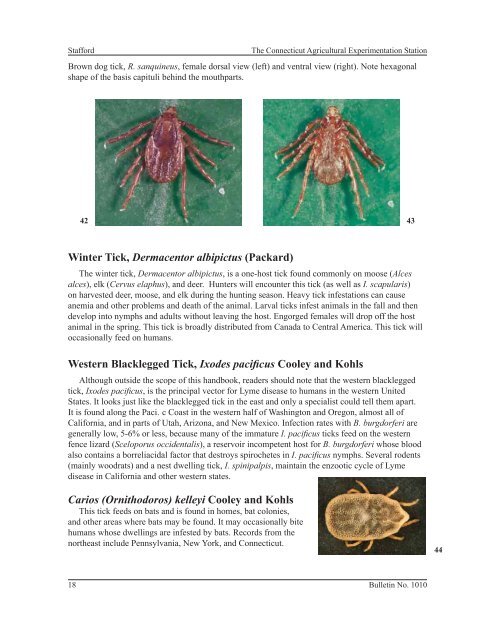<strong>Stafford</strong>The Connecticut Agricultural Experimentation StationBrown dog tick, R. sanquineus, female dorsal view (left) and ventral view (right). Note hexagonalshape of the basis capituli behind the mouthparts.4243Winter <strong>Tick</strong>, Dermacentor albipictus (Packard)The winter tick, Dermacentor albipictus, is a one-host tick found commonly on moose (Alcesalces), elk (Cervus elaphus), and deer. Hunters will encounter this tick (as well as I. scapularis)on harvested deer, moose, and elk during the hunting season. Heavy tick infestations can causeanemia and other problems and death of the animal. Larval ticks infest animals in the fall and thendevelop into nymphs and adults without leaving the host. Engorged females will drop off the hostanimal in the spring. This tick is broadly distributed from Canada to Central America. This tick willoccasionally feed on humans.Western Blacklegged <strong>Tick</strong>, Ixodes pacificus Cooley and KohlsAlthough outside the scope of this handbook, readers should note that the western blackleggedtick, Ixodes pacificus, is the principal vector for Lyme disease to humans in the western UnitedStates. It looks just like the blacklegged tick in the east and only a specialist could tell them apart.It is found along the Paci. c Coast in the western half of Washington and Oregon, almost all ofCalifornia, and in parts of Utah, Arizona, and New Mexico. Infection rates with B. burgdorferi aregenerally low, 5-6% or less, because many of the immature I. pacificus ticks feed on the westernfence lizard (Sceloporus occidentalis), a reservoir incompetent host for B. burgdorferi whose bloodalso contains a borreliacidal factor that destroys spirochetes in I. pacificus nymphs. Several rodents(mainly woodrats) and a nest dwelling tick, I. spinipalpis, maintain the enzootic cycle of Lymedisease in California and other western states.Carios (Ornithodoros) kelleyi Cooley and KohlsThis tick feeds on bats and is found in homes, bat colonies,and other areas where bats may be found. It may occasionally bitehumans whose dwellings are infested by bats. Records from thenortheast include Pennsylvania, New York, and Connecticut.4418Bulletin No. 1010
<strong>Stafford</strong>Imported ticksThe Connecticut Agricultural Experimentation StationTravelers abroad have found exotic ticks on themselves after returning to the United States.Other ticks may be imported on pets and other animals. Some of these ticks are potential vectorsof pathogens of domestic livestock and introduction and establishment of these ticks would haveserious consequences for the livestock industry. For humans, there are a number of bacterial andrickettsial pathogens and encephalitis and hemorrhagic fever viruses carried by ticks in Europe,Asia, Africa and Australia. For example, cases of boutonneuse fever, also called Mediterraneanspotted fever, have occurred in travelers returningto the U.S. Boutonneuse fever is distributed throughAfrica, countries around the Mediterranean, southernEurope, and India. Other spotted fever diseases areAfrican tick-bite fever, Siberian tick typhus, andQueensland tick typhus.Several tick-borne encephalitis viruses, as well asLyme disease spirochetes, are transmitted by Ixodesricinus ticks in the British Isles, central and EasternEurope, and Russia and by Ixodes persulcatus fromcentral Europe, Russia, parts of China, and Japan.The following ticks have been documented fromtraveler’s returning to the northeast (destination,origin): Amblyomma cajennense (<strong>CT</strong>, Jamaica), A. hebraeum (<strong>CT</strong>, South Africa), A. variegatum(NY, Kenya), Rhipicephalus simus (<strong>CT</strong>, Kenya), Dermacentor auratus (ME, Nepal), and Hyalomamarginatum (<strong>CT</strong>, Greece). The Connecticut travelers returning from South Africa and Kenya werediagnosed with boutonneuse fever. <strong>Tick</strong> bite prevention measures should be taken by travelers topotentially tick infested areas abroad. Physicians should consider exotic tick-associated diseases inthe differential diagnosis for a patient with a travel history outside the United States.Louse Flies of Deer May Be Confused with <strong>Tick</strong>sThese . ies are tick-like, blood-feeding parasitic . ies (familyHippoboscidae), which may be confused with true ticks. Theadult . ies are dorsally . attened like a tick, with six legs. Severalspecies are common parasites of white-tailed deer in the U.S. andare frequently seen by hunters or others in close association withdeer. One species, Lipoptena cervi is known as the “deer ked” andwas imported from Europe. It occasionally will bite humans. Other“deer keds” are native to the U.S. The female . y retains the larvae,nourishing them internally, and then lays mature larvae, whichpromptly pupate. The hippoboscid . ies associated with deer havewings when they emerge, but lose them once they . nd a host.Amblyomma hebraeum, one exotic species thathas been imported into the U.S. Found throughoutsouthern Africa, it is a vector for Rickettsiaconori, the agent of boutonneuse fever. (J. Occi).4546Bulletin No. 1010 19











